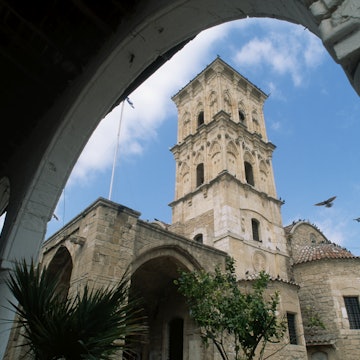

Explore the history of the Green Line © Iakovos Hatzistavrou/Getty Images
Unlike many fortified cities, Nicosia (Lefkosia) isn’t defined by its surrounding walls. Venetian bastions still enclose the old part of the city, but a much newer barrier holds sway. The so-called Green Line – a demilitarised buffer zone patrolled by United Nations peacekeepers – scythes through the middle of town, slicing it in two. This is Europe’s last divided capital, but its entwined history straddles both sides.
Try to explore the old town’s atmospheric tangle of alleyways, or trace the line of its geometrically perfect, snowflake-shaped ramparts, and you’ll run into one major problem: narrow lanes end abruptly at cement bunkers and oil-barrel barricades, with a no man’s land of abandoned buildings standing beyond the barbed-wire fencing.
Understanding the Green Line
The UN Buffer Zone (commonly called the Green Line) was marked out in 1964 as a temporary measure to restore peace after a decade of inter-communal fighting between Turkish and Greek Cypriots in the fledgling independent nation of Cyprus. Instead, the barrier has remained in place ever since, expanding to slice through the entire island.

In the capital, the Green Line separates Nicosia (Lefkosia), the capital of the majority Greek-Cypriot Republic of Cyprus, from North Nicosia (Lefkoşa), capital of the Turkish Republic of Northern Cyprus, recognized only by the government of Turkey.
These days most international visitors (and Cypriots themselves) can easily hop between both sides, thanks to the loosening of cross-border restrictions in the early 2000s. This means that Nicosia’s impressive clutch of museums, which piece together the jigsaw puzzle of the city’s past, and the monuments of North Nicosia that highlight the city’s Ottoman character, can be experienced during the same visit.
The 15 best things to do in Nicosia: from Venetian walls to Turkish baths
Agia Sofia – a symbol of a complex history
The city’s complicated history is encapsulated best by one building. The Church of Agia Sofia was consecrated under Lusignan rule in the 14th century, then put at the forefront of city planning after the Venetians seized Cyprus in 1489. The Venetians built their fortifications around Nicosia so that the Agia Sofia stood in the centre, but those walls failed to halt the advance of the Ottoman Empire, and the church was transformed into the Selimiye Mosque in the 16th century.

Today its twin minarets tower over North Nicosia’s old town. In bustling Arasta Sokak below, stalls vie for business with knock-off designer sweatpants and leggings, kebab vendors fire up the grills to tempt tour groups who have crossed over from the South, and a handful of new cafes are popping up within the fray, adding a dusting of cosmopolitan cafe culture.
Enter the mosque, though, and a timeless calm prevails. The plain whitewashed interior (in keeping in with the religious requirements of Islam) highlights the soaring ribbed vaulting, fusing together Gothic splendour and the meditative minimalism of Islam. But the building’s Christian origins are still very apparent from its grand, Gothic exterior and its arched windows, whose medieval stained glass was shattered by the Ottoman rulers of Nicosia and replaced with perforated panels.
Rediscovering pre-partition Nicosia
Running through the historic Taht-el-Kale district in the southern part of Nicosia, Ermou St was once the thriving hub of the old town, but the Buffer Zone put paid to that when its blockades sliced the thoroughfare in two. However, these days this long-neglected area is slowly being regenerated, with investment from the European Union, and the Centre of Visual Arts and Research (CVAR) museum is spearheading that revival.
For anyone interested in Cypriot life under British rule and in the early years of independence, the galleries here are chock-full of documents, artworks by international artists who traveled to Cyprus from the 18th to the 20th centuries, and memorabilia which brings alive the Cyprus story, the daily life of previous eras and the political tug of war which led to the division of the island.
Head to the old city’s residential neighbourhoods to capture a sense of life before the division. From Ermou St, eerily quiet lanes splay out into the Chrysaliniotissa quarter where cottage rows back directly onto the Green Line. This was once a lively community of both Greek and Turkish Cypriots, with only a few alleys between the diminutive Taht-el-Kale Mosque and the Byzantine-era Panagia Chrysaliniotissa church.
Today the mosque still stands but the people who once worshipped here abandoned the area for the safety of Turkish Cypriot-majority districts of the city during the eruption of violence in 1963. Across Cyprus, a similar migration saw previously mixed villages become predominantly Turkish or Greek Cypriot as families from both communities sought refuge from communal violence.
Stepping outside Europe in North Nicosia
Today, the Republic of Cyprus is part of the European Union (EU), and this has brought considerable investment to the southern half of the capital.

But crossing into North Nicosia via the checkpoint on Ledra St – at the end of the south’s most chic shopping strip – you’ll emerge into the dusty Arabahmet quarter, where once elegant Ottoman architecture has sunk into a state of teetering dilapidation. Sandwiched into a wedge of the old town rubbing up against the curve of the Venetian walls to the west and the ragtag barricades of the Green Line to the south, the tall townhouses here were once home to a mix of high-up Ottoman officials and Armenian traders.
The Armenian community was ousted (fleeing for safety into the southern half of the city) in 1963, but vestiges of its tenure can easily be picked out from the crosses carved into door lintels and by visiting Arabahmet’s recently restored Armenian Church, the community’s main place of worship before the separation.
Nearby, Zahra Sokak runs along the edge of the old town’s walls with vistas across the empty moat. At the end of the road, the scruffy park atop the Roccas Bastion hosts the oddest geopolitical view in town. Through the barbed-wire fencing, you can peer down into streets that form part of the European Union, while you – just a few metres above – are standing outside the EU, in a state recognized only by the government of Turkey.
It’s a strange concept to get your head around, but consider how it felt for local residents before crossing the Green Line was normalised in 2003, when this was one of the few places where Greek and Turkish Cypriots could see and speak to each other up close.
Crossing over the Green Line back into Nicosia via the main Ledra St guard post, you’ll be swept back into city life. Lined with boutiques and major European brands, this is where the action moved after the island’s division. Side streets buzz with bars and cafes, where customers spill out onto pavement seating until the wee hours, while buskers brandishing guitars and accordions crank out competing tunes.

Head here for a slap-up feast of souvlaki and sheftalia (pork and lamb crepinettes) at Piatsa Gourounaki after you’re done sightseeing, then head on to Brew Fellas or Pivo Microbrewery for a drink.
Make it happen
Under normal circumstances, crossing the Green Line is easy for most international visitors, though crossings can be suspended at times of political tension, or for public health reasons. The main pedestrian checkpoints between Nicosia and North Nicosia are at Ledra St, in the middle of the old city, and at Ledra Palace, just west of the Venetian walls, named for the once-grand Ledra Palace Hotel.
Bring your passport when crossing the Green Line; both crossings are open 24 hours a day and there are no restrictions on the number of times you can cross. Non-EU passport holders wanting to explore both sides of the city should arrive on the island within the Republic of Cyprus (at either Larnaka or Pafos airports). Greek Cypriot authorities can officially disallow entry to non-EU citizens who fly into Ercan airport or arrive by ferry from Turkey into the Turkish Republic of North Cyprus.
Note that while the Green Line is not considered part of the external boundary of the European Union, customs regulations apply, affecting, amongst other things, the movement of halloumi cheese! To unravel the regulations, check out the online information provided by the European Union and the government of the Republic of Cyprus.
Nicosia is on our 2022 Best of Travel list. For more stories from some of the world’s most exciting destinations click here.
Safety recommendations and restrictions during a pandemic can change rapidly. Lonely Planet recommends that travelers always check with local authorities for up-to-date guidance before traveling during COVID-19.
You might also like:
The 9 best museums and churches in Nicosia
See a different side to Cyprus on these stunning hikes
The best things to do in Cyprus: sun, sand and ancient civilizations













